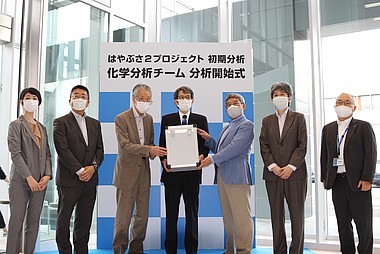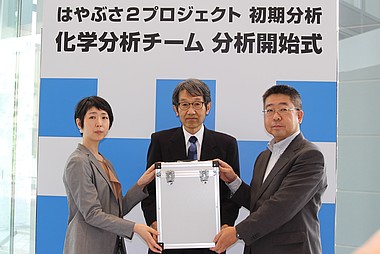HORIBA TECHNO SERVICE Co., Ltd. (hereinafter, "HORIBA TECHNO SERVICE") is participating in a project as a member of the chemical analysis team for the initial analysis of samples, including sand and gravel, that the Japan Aerospace Exploration Agency's (JAXA's) Asteroid Explorer Hayabusa2 has collected from the asteroid Ryugu. To commemorate the commencement of full-fledged analysis by the chemical analysis team, a ceremony was observed on June 24th at Analytical Solution Plaza, HORIBA TECHNO SERVICE's state-of-the-art analysis laboratories.
It is believed that Ryugu has an asteroid carrying information from the early stages of the formation of the Solar System, and also contains a plethora of organic substances and water. Much is expected from the analysis of the samples collected from Ryugu to elucidate the origins and evolution of the Solar System and life.
About the chemical analysis team
The samples collected from Ryugu will be subjected to an initial analysis by six teams*1. Led by Professor Hisayoshi Yurimoto of Hokkaido University, the team comprises about 50 members from universities, research institutions, and private enterprises. To reveal the chemical characteristics of the samples collected from Ryugu, they will investigate chemical compositions, such as the types and ratios of elements in the samples, and isotope*2 compositions of the elements. These analyses are designed to explore Ryugu's origin and formation by shedding light on how the asteroid is related to types of meteorites that fall to Earth. As more data and knowledge are accumulated through these attempts, we can expect to get closer to the elucidation of the origins and evolution of the Solar System and life.
HORIBA's Roles
HORIBA uses its X-ray fluorescence analysis*3 equipment to perform non-destructive, non-contact analysis of elements contained in the samples collected from Ryugu. As the samples used for analysis are in minute quantities, HORIBA TECHNO SERVICE was chosen to participate in the project due to its expertise in high-precision microanalysis. HORIBA will also conduct Raman spectroscopic analysis*4 to identify what minerals are present, based on the chemical state of carbon and differences in molecular structures.
Overview of the Ceremony
Date and time: June 24, 2021, 11:00-11:30
Place: 1F, Kyoto Head Office, HORIBA TECHNO SERVICE
Attendees: Members of the chemical analysis team
・Professor, DSc, Faculty of Science, Hokkaido University (Leader, chemical analysis team) Hisayoshi Yurimoto, DSc
・Professor Emeritus, DSc, Tokyo University of Science Izumi Nakai, DSc
・Professor, Ph.D., Tokyo University of Science Hiroharu Yui, Ph.D.
・DSc, Spectroscopy and Imaging Division, Japan Synchrotron Radiation Research Institute (JASRI) Yasuko Terada, Ph.D.
・Ph.D., Osaka Application Laboratory, SBU : WDX, X-ray Instrument Division, Rigaku Corporation Hisashi Honma, Ph.D.
・Director, Ph.D., Analytical Technology Division, HORIBA TECHNO SERVICE CO., LTD. Shintaro Komatani, Ph.D.
・General Manager, Analytical Technology Department, Analytical Technology Division, HORIBA TECHNO SERVICE CO., LTD. Tomoko Numata
Program:
11:00–11:10 Greetings: Roles and Significance of the Chemical Analysis Team (Hisayoshi Yurimoto)
11:10–11:20 Handing Over the Samples (Hisayoshi Yurimoto, Hisashi Honma, Tomoko Numata)
11:20–11:30 Announcement of the Commencement of Analysis (Hisashi Honma, Tomoko Numata)
Greetings by Professor Hisayoshi Yurimoto, Hokkaido University (Summary)
The findings from the initial analysis should result in subsequent research, which will then catalyze scientific progress, allowing us to explore the origins of the Solar System and life. To this end, the initial chemical analysis team is responsible for revealing the chemical characteristics of the samples collected from the asteroid Ryugu, such as types and quantities of elements present, and share a database with researchers worldwide.
We hope to fulfill our roles by conducting detailed analyses for a year or so.
Developments of the initial analysis of the samples from Ryugu
Launched in December 2014 from the JAXA Tanegashima Space Center, Asteroid Explorer Hayabusa2 delivered a capsule containing the samples from Ryugu back to Earth in December 2020. Upon the arrival of the sample return capsule, the samples were subjected to the curation (initial observation) process. On June 17, 2021, the samples were handed over to the initial analysis team, who will analyze the samples for roughly one year. Once the initial analysis is completed, the samples will be put in storage and proposals for examinations of the samples will be invited from around the world.
*1 Chemical analysis team, stony material analysis team, sandy material analysis team, volatile component analysis team, organic macromolecule analysis team, and soluble organics analysis team
*2 Atoms of the same element that have the same atomic number but different mass numbers
*3 An analytical technique for assessing types and quantities of elements contained in a substance by capturing X-rays unique to each element (fluorescence X-ray) emitted when the substance is irradiated with X-rays
*4 An analytical technique for identifying molecular structures of samples and evaluating their properties by detecting light scattered from the samples (Raman scattered light) when they are irradiated with light



